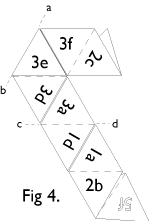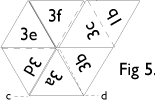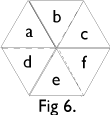Making a Hexaflexagon
Symmetric hexaflexagons are made from a strip of paper
which has been creased into equilateral triangles.
The strip is then folded along the creases into a flexagon.
My examples are for trihexaflexagons,
hexahexaflexagons, and dodecahexaflexagons, which have
3, 6, and 12 faces, respectively.
To make a higher order hexaflexagon, use a longer strip of paper
and fold adjacent like-numbered faces
together until you've reduced the strip to figure 1.
The letters after each number in the examples represent the
location that triangle has in that face's
canonical representation (as in figure 6).
The faces are numbered such that faces 1, 2, and 3 are the faces
of a trihexaflexagon, and adding
faces 4, 5, and 6 yields the additional faces of a hexahexaflexagon,
etc. That way, the face numbers
remain consistent for a trihexaflexagon, a hexahexaflexagon,
a dodecahexaflexagon, or any higher order.
The strip of paper is longer, but the face numbering is consistent.
For a dodecahexaflexagon begin with figure 1, for a hexahexaflexagon
begin with figure 2, and for a trihexaflexagon begin with figure 3.
Lay out a dodecahexaflexagon as follows on two strips of paper.
(It's generally too long to lay out on one unless you're using
adding machine tape or something like that.)

Fold adjacent like-numbered faces together to yield figure 2.
Begin with figure 2 for a hexahexaflexagon.

Fold the adjacent like-numbered faces on the back side together,
yielding figure 3.
Begin with figure 3 for a trihexaflexagon.

Fold back along line ab, and then back along line cd, yielding
figure 4 and then 5.
Fold over the last triangle and glue in place yielding figure 6.



The flexagon is now complete. (I left out the ones before the face letters for clarity on a small screen.)